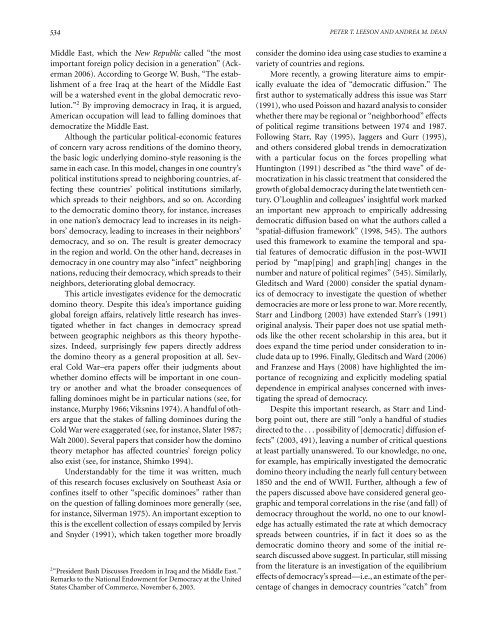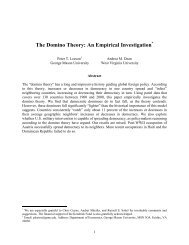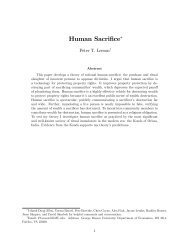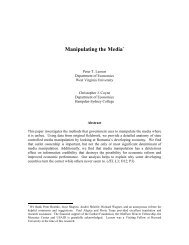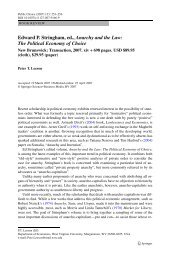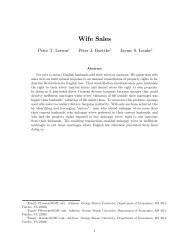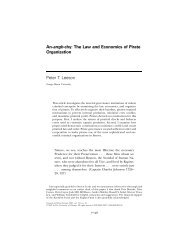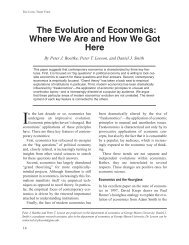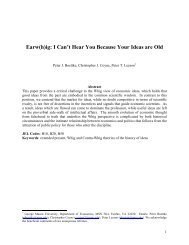The Democratic Domino Theory: An Empirical Investigation
The Democratic Domino Theory: An Empirical Investigation
The Democratic Domino Theory: An Empirical Investigation
Create successful ePaper yourself
Turn your PDF publications into a flip-book with our unique Google optimized e-Paper software.
534 PETER T. LEESON AND ANDREA M. DEAN<br />
Middle East, which the New Republic called “the most<br />
important foreign policy decision in a generation” (Ackerman<br />
2006). According to George W. Bush, “<strong>The</strong> establishment<br />
of a free Iraq at the heart of the Middle East<br />
will be a watershed event in the global democratic revolution.”<br />
2 By improving democracy in Iraq, it is argued,<br />
American occupation will lead to falling dominoes that<br />
democratize the Middle East.<br />
Although the particular political-economic features<br />
of concern vary across renditions of the domino theory,<br />
the basic logic underlying domino-style reasoning is the<br />
same in each case. In this model, changes in one country’s<br />
political institutions spread to neighboring countries, affecting<br />
these countries’ political institutions similarly,<br />
which spreads to their neighbors, and so on. According<br />
to the democratic domino theory, for instance, increases<br />
in one nation’s democracy lead to increases in its neighbors’<br />
democracy, leading to increases in their neighbors’<br />
democracy, and so on. <strong>The</strong> result is greater democracy<br />
in the region and world. On the other hand, decreases in<br />
democracy in one country may also “infect” neighboring<br />
nations, reducing their democracy, which spreads to their<br />
neighbors, deteriorating global democracy.<br />
This article investigates evidence for the democratic<br />
domino theory. Despite this idea’s importance guiding<br />
global foreign affairs, relatively little research has investigated<br />
whether in fact changes in democracy spread<br />
between geographic neighbors as this theory hypothesizes.<br />
Indeed, surprisingly few papers directly address<br />
the domino theory as a general proposition at all. Several<br />
Cold War–era papers offer their judgments about<br />
whether domino effects will be important in one country<br />
or another and what the broader consequences of<br />
falling dominoes might be in particular nations (see, for<br />
instance, Murphy 1966; Viksnins 1974). A handful of others<br />
argue that the stakes of falling dominoes during the<br />
Cold War were exaggerated (see, for instance, Slater 1987;<br />
Walt 2000). Several papers that consider how the domino<br />
theory metaphor has affected countries’ foreign policy<br />
also exist (see, for instance, Shimko 1994).<br />
Understandably for the time it was written, much<br />
of this research focuses exclusively on Southeast Asia or<br />
confines itself to other “specific dominoes” rather than<br />
on the question of falling dominoes more generally (see,<br />
for instance, Silverman 1975). <strong>An</strong> important exception to<br />
this is the excellent collection of essays compiled by Jervis<br />
and Snyder (1991), which taken together more broadly<br />
2 “President Bush Discusses Freedom in Iraq and the Middle East.”<br />
Remarks to the National Endowment for Democracy at the United<br />
States Chamber of Commerce, November 6, 2003.<br />
consider the domino idea using case studies to examine a<br />
variety of countries and regions.<br />
More recently, a growing literature aims to empirically<br />
evaluate the idea of “democratic diffusion.” <strong>The</strong><br />
first author to systematically address this issue was Starr<br />
(1991), who used Poisson and hazard analysis to consider<br />
whether there may be regional or “neighborhood” effects<br />
of political regime transitions between 1974 and 1987.<br />
Following Starr, Ray (1995), Jaggers and Gurr (1995),<br />
and others considered global trends in democratization<br />
with a particular focus on the forces propelling what<br />
Huntington (1991) described as “the third wave” of democratization<br />
in his classic treatment that considered the<br />
growth of global democracy during the late twentieth century.<br />
O’Loughlin and colleagues’ insightful work marked<br />
an important new approach to empirically addressing<br />
democratic diffusion based on what the authors called a<br />
“spatial-diffusion framework” (1998, 545). <strong>The</strong> authors<br />
used this framework to examine the temporal and spatial<br />
features of democratic diffusion in the post-WWII<br />
period by “map[ping] and graph[ing] changes in the<br />
number and nature of political regimes” (545). Similarly,<br />
Gleditsch and Ward (2000) consider the spatial dynamics<br />
of democracy to investigate the question of whether<br />
democracies are more or less prone to war. More recently,<br />
Starr and Lindborg (2003) have extended Starr’s (1991)<br />
original analysis. <strong>The</strong>ir paper does not use spatial methods<br />
like the other recent scholarship in this area, but it<br />
does expand the time period under consideration to include<br />
data up to 1996. Finally, Gleditsch and Ward (2006)<br />
and Franzese and Hays (2008) have highlighted the importance<br />
of recognizing and explicitly modeling spatial<br />
dependence in empirical analyses concerned with investigating<br />
the spread of democracy.<br />
Despite this important research, as Starr and Lindborg<br />
point out, there are still “only a handful of studies<br />
directed to the ...possibility of [democratic] diffusion effects”<br />
(2003, 491), leaving a number of critical questions<br />
at least partially unanswered. To our knowledge, no one,<br />
for example, has empirically investigated the democratic<br />
domino theory including the nearly full century between<br />
1850 and the end of WWII. Further, although a few of<br />
the papers discussed above have considered general geographic<br />
and temporal correlations in the rise (and fall) of<br />
democracy throughout the world, no one to our knowledge<br />
has actually estimated the rate at which democracy<br />
spreads between countries, if in fact it does so as the<br />
democratic domino theory and some of the initial research<br />
discussed above suggest. In particular, still missing<br />
from the literature is an investigation of the equilibrium<br />
effects of democracy’s spread—i.e., an estimate of the percentage<br />
of changes in democracy countries “catch” from


